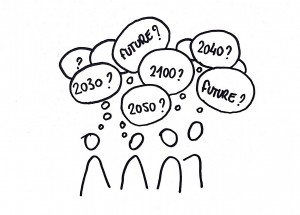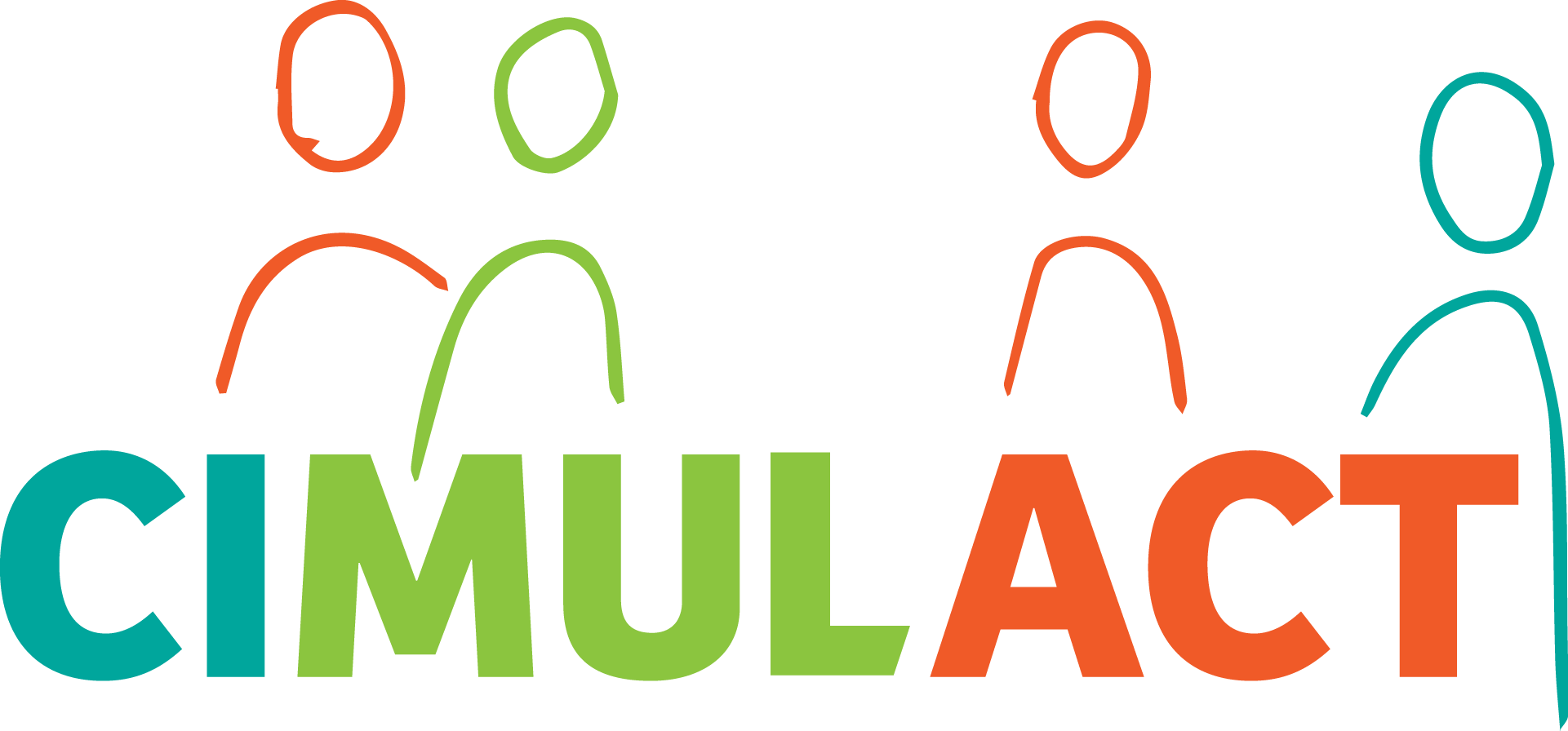 In CIMULACT we work with a notion of Foresight as a “structured dialogue on long-term futures”19. In this understanding Foresight dialogue is participatory, recognizes a range of alternative futures, looks at the systemic interplay of different factors (technology, society, economy) and is structured by methods that ensure the emergence of collective intelligence and foster long-term orientation.
In CIMULACT we work with a notion of Foresight as a “structured dialogue on long-term futures”19. In this understanding Foresight dialogue is participatory, recognizes a range of alternative futures, looks at the systemic interplay of different factors (technology, society, economy) and is structured by methods that ensure the emergence of collective intelligence and foster long-term orientation.
Why Foresight?
CIMULACT draws on Foresight elements for the following reasons: Firstly, the future provides a space for negotiating the presence that allows for transgressing today’s thought limitations and silos. Secondly Foresight provides a range of methods for harnessing the power of collective intelligence of diverse groups such as in the case of CIMULACT citizens, scientists and stakeholders. Finally, within the last decades Foresight has been well established as a policy instrument in a number of domains but in particular research, technology and innovation (RTI) policy20. Also on the EC level forward-looking activities are increasingly meant to inspire new EU policies by providing fresh insights and identifying major societal challenges21. While the early RTI Foresights mainly involved researchers and industry experts and focused on technology issues, Foresighters have long pointed to the need of involving citizens both as key stakeholders and experts, so Foresight processes do more and more rest on strong citizens’ participation and tackle societal demands22,23. Therefore by linking Foresight and citizen participation approaches we expect a major step forward in enhancing policymakers’ ability to set scientific courses in line with societal needs and aspirations.
A long tradition of theory development
Today’s Foresight methodological framework rests on a long tradition of theory development in diverse disciplines such as philosophy, sociology, cognitive psychology, policy studies, economics and strategic management. The concept of visioning has been widely used since the 1980s and 1990s, and even became synonymous with public participation. Planners and communities developed many different methods of varying quality, which all share the goal of creating images of the future that serve as guidelines for future development24,25. Many methods apply the concept of “Leitbild” to guide heterogeneous participants on the way towards a certain vision. This is done by consciously intersecting desirable and feasible future developments26,27 and define visions as an image of a desirable future, which makes them a valuable tool for identifying the diverse needs and values of citizens thinking of a variety of futures. In CIMULACT ‘needs’ are understood as “the most fundamental dimensions of human flourishing and are not good, nor bad, not sustainable or unsustainable […and] high quality of life is strongly linked to the fulfilment of individual needs”28. With regard to long-term planning linked to the concept of sustainability, it is crucial to integrate ‘multiple legitimate needs’29 in the form of involving ‘extended peer communities’, especially when decision stakes and systems’ uncertainty are high30. Failing to consider this plurality of legitimate perspectives in the process of shaping future science, technology and innovation policies may exclude legitimate expectations of laypeople in these areas.
Scenarios and visions are based on different kinds of knowledge. Glickeni31 distinguishes three qualities: cognitive, experiential and value-based knowledge. Cognitive knowledge derives from individual expertise whereas experiential knowledge is based on common sense and personal experience. Value based knowledge is moral or normative and emerges from societies. Scenarios are based on cognitive knowledge on current socio-political, technological and/or economic trends. They intend to show possible self-consistent paths of development, which discerns them from classical prognoses. Scenarios can be viewed as stories that reflect one or more potentially possible futures or even just aspects of it. They are often based on the extrapolation of current trends32. A scenario is thus an internally consistent picture of what could be in the future. Scenarios are no predictions, but a possibility of how the future may look like33.
Accordingly, the CIMULACT “research programme scenarios” will outline possible alignments of scientific progress and social needs as an inspiration for H2020. CIMULACT will uniquely integrate well-established methods of citizen participation and Foresight approaches jointly developed by leading research teams of both communities. In terms of methodology we will draw on Foresight methods to generate collective intelligence not only across diverse disciplines and cultural contexts as it is common in Foresight but also between scientists and citizens which is a fairly novel endeavour. For this purpose we have designed a methodological framework combining horizon scanning, visioning and joint exploration of what-if questions through scenario development and finally multi-criteria analysis. Throughout the process we make extensive use of visual elements to bridge domains and elicit tacit knowledge and out of the box thinking34.
What is a vision?
In the proposed project the term vision is employed according to the definition used in the CIVISTI project: “Vision […] is a picture or an imagination of a desirable future. A vision can be based upon hopes and dreams—but also upon concerns and fears in relation to problems or imagined threats, which we do not want to become future reality. The time span of the vision is 30–40 years from now35.” The method allows citizens to include their expectations of the future, their thoughts and concerns about it into the visions (experiential and normative knowledge).
19 JRC-IPTS (2014) Forlearn online Foresight Guide. Foresight Characteristics. Last Accessed 22.09.2014
20 Salo, A. and Cuhls, K. (2003): Technology Foresight – Past and Future. Journal of Forecasting, 22, 79−82
21 European Commision (2010) European forward looking activities: EU research in foresight and forecast. Socio-economic sciences and humanities. List of Activities 2007–2010.
22 Warnke, P., Heimeriks, G. (2008). Technology Foresight as Innovation Policy Instrument: Learning from Science and Technology Studies. In: Cagnin, C., Keenan, M., Johnston, R., Scapolo, F. and Barre, R. (Eds.): Future-Oriented Technology Analysis. Strategic Intelligence for an Innovative Economy. London: Springer, 71−87
23 Quist, J., Vergragt, P. (2006) Past and future of backcasting: The shift to stakeholder participation and a proposal for a methodological framework. Futures, Volume 38, Issue 9, November 2006, Pages 1027-1045
24 Shipley R (2002) Visioning in planning: is the practice based on sound theory? Environ Plan A 34:7–22
25 Van der Helm, R. (2014) The vision phenomenon: Towards a theoretical underpinning of visions of the future and the process of envisioning. Futures, Volume 41, Issue 2, March 2009, Pages 96-104
26 Dierkes M, Hoffmann U et al (1992) Leitbild und Technik: Zur Entstehung und Steuerung technischer Innovationen. Rainer Bohn, Berlin
27 Beers PJ, Veldkamp A, Hermans F, van Apeldoorn D, Vervoort JM, Kok K (2010) Future sustainability and images. Futures 42:723–732
28 Grünberger S, Omann I (2011) Quality of life and sustainability. Links between sustainable behaviour, social capital and well-being. Paper presented at the 9th biennial conference of the European Society of Ecological Economics (ESEE): “Advancing Sustainability in a Time of Crisis. 14th–17th June, Instanbul, Turkey
29 Sotoudeh M, Peissl W, Gudowsky N, Jacobi A (2011) Long-term planning for sustainable development: CIVISTI method for futures studies with strong participative elements. ITA-manu:script 11-03, doi: 10.1553/ITA-ms-11-03.
30 Funtowicz S, Ravetz J (2001) Post-normal science—science and governance under conditionns of complexity. In: Decker M (ed) Interdisciplinarity in technology assessment: implementation and its chances and limits. Springer, Berlin, pp 15–24
31 Glicken, J., (2000) Getting stakeholder participation ‘right’: a discussion of participatory processes and possible pitfalls. Environmental Science and Policy 3, pp. 305–310.
32 Mantovani E, 2012: Value Ageing Deliverable 5.2, Scenario generation and validation report, pdf.
33 Porter, M. 1985: Competitive Advantage. Free press New York
34 Schirrmeister, E, Warnke,P.: Envisioning structural transformation — lessons from a foresight project on the future of innovation, Technological Forecasting and Social Change, Volume 80, Issue 3, March 2013, Pages 453-466
35 Rask and Damianova (2009), Citizen Visions – Preliminary Content Report, p 9.
